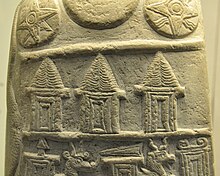
Back Anoe Afrikaans أنو (أسطورة) Arabic أنو (ميثولوجيا) ARZ Anu Azerbaijani Ан Byelorussian Ану Bulgarian আনু Bengali/Bangla An Catalan Anu CEB An (božstvo) Czech
| Anu 𒀭𒀭 | |
|---|---|
Sky Father, King of the Gods | |
 Symbols of various deities, including Anu (bottom right corner) on a kudurru of Ritti-Marduk, from Sippar, Iraq, 1125–1104 BCE | |
| Abode | heaven |
| Symbol | horned crown on a pedestal |
| Number | 60 |
| Personal information | |
| Parents | |
| Consort | |
| Children | |
| Equivalents | |
| Greek equivalent | Zeus (disputed),[5] Uranus[6] |
| Elamite equivalent | Jabru[7] |
| Hurrian equivalent | Hamurnu[8] |
| Achaemenid equivalent | Ahura Mazda[5] (disputed)[9] |
Anu (Akkadian: 𒀭𒀭 ANU, from 𒀭 an "Sky", "Heaven") or Anum, originally An (Sumerian: 𒀭 An),[10] was the divine personification of the sky, king of the gods, and ancestor of many of the deities in ancient Mesopotamian religion. He was regarded as a source of both divine and human kingship, and opens the enumerations of deities in many Mesopotamian texts. At the same time, his role was largely passive, and he was not commonly worshipped. It is sometimes proposed that the Eanna temple located in Uruk originally belonged to him, rather than Inanna, but while he is well attested as one of its divine inhabitants, there is no evidence that the main deity of the temple ever changed, and Inanna was already associated with it in the earliest sources. After it declined, a new theological system developed in the same city under Seleucid rule, resulting in Anu being redefined as an active deity. As a result he was actively worshipped by inhabitants of the city in the final centuries of the history of ancient Mesopotamia.
Multiple traditions regarding the identity of Anu's spouse existed, though three of them—Ki, Urash, and Antu—were at various points in time equated with each other, and all three represented earth, similar to how he represented heaven. In a fourth tradition, more sparsely attested, his wife was the goddess Nammu instead. In addition to listing his spouses and children, god lists also often enumerated his various ancestors, such as Anshar or Alala. A variant of one such family tree formed the basis of the Enūma Eliš.
Anu briefly appears in the Akkadian Epic of Gilgamesh, in which his daughter Ishtar (the Akkadian counterpart of Inanna) persuades him to give her the Bull of Heaven so that she may send it to attack Gilgamesh. The incident results in the death of the Bull of Heaven and a leg being thrown at Ishtar's head. In another myth, Anu summons the mortal hero Adapa before him for breaking the wing of the south wind. Anu orders for Adapa to be given the food and water of immortality, which Adapa refuses, having been warned beforehand by Enki that Anu will offer him the food and water of death. In the Hurrian myths about Kumarbi, known chiefly from their Hittite translations, Anu is a former ruler of the gods, who was overthrown by Kumarbi, who bit off his genitals and gave birth to the weather god Teshub. It is possible that this narrative was later the inspiration for the castration of Ouranos in Hesiod's Theogony. It has also been proposed that in the Hellenistic period Anu might have been identified with Zeus, though this remains uncertain.
- ^ Lambert 2013, p. 238.
- ^ Wang 2011, p. 152.
- ^ Lambert 2013, p. 405.
- ^ Wiggermann 1998, p. 138.
- ^ a b Krul 2018, p. 41.
- ^ Burkert 2005, p. 295.
- ^ Lambert 1980, p. 229.
- ^ Lambert 2007, p. 169.
- ^ Beaulieu 2018, p. 203.
- ^ Stephens 2013.
© MMXXIII Rich X Search. We shall prevail. All rights reserved. Rich X Search